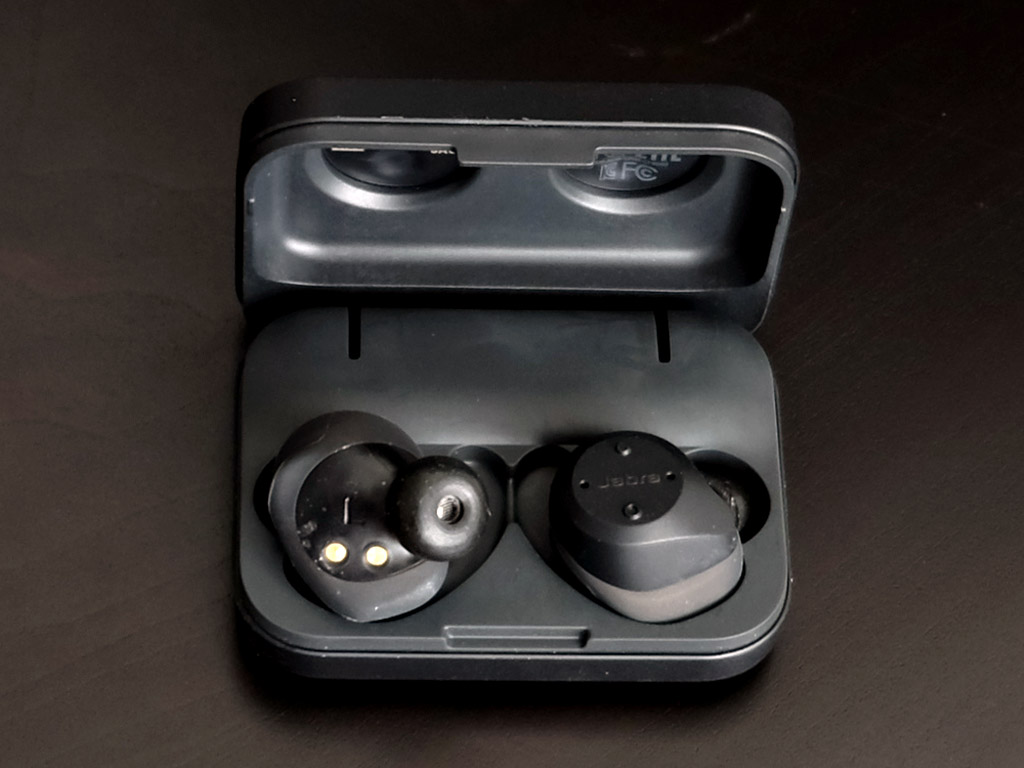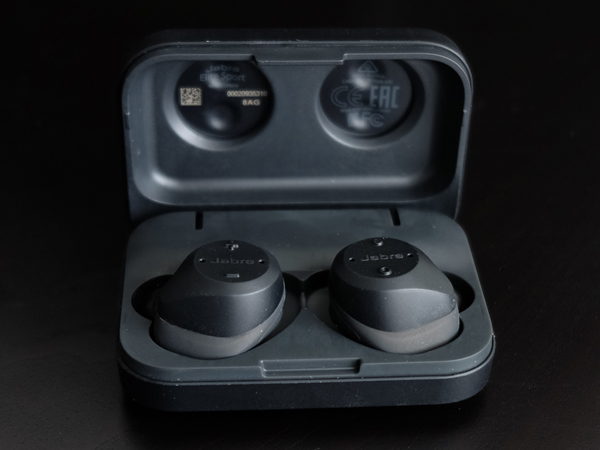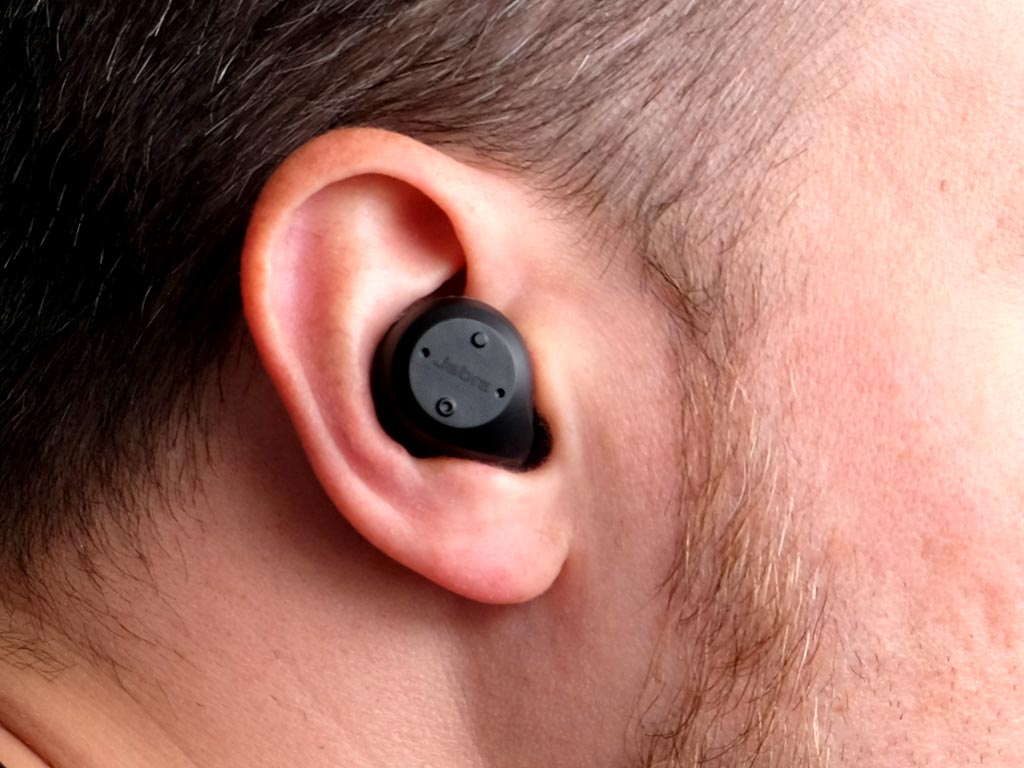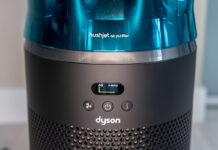
The term “cord-cutting” usually refers to cutting off a cable TV subscription, but the movement toward making headphones and earbuds wireless is already afoot, and Jabra is aiming to lead the way with the Sport Elite. Entirely cord-free, these wireless Bluetooth earbuds are designed to ensure tangled cables are never a problem, while throwing in certain fitness features to keep you moving.
If your initial thought is to be frightened at losing one of the earbuds, the included case helps to maintain a semblance of orderly storage. The case doubles as a battery charger, and that alone would be one reason to make sure it is always handy. I’ll touch on all those aspects further down, but it is true that going completely cord-free does require some time to get used to.
Jabra Sport Elite Design and setup
 Apart from being fully wireless and cord-free, Jabra designed the Sport Elite to be rugged and robust. They are waterproof, and given their fitness focus, have a higher level of sweat resistance than other wireless earbuds.
Apart from being fully wireless and cord-free, Jabra designed the Sport Elite to be rugged and robust. They are waterproof, and given their fitness focus, have a higher level of sweat resistance than other wireless earbuds.
On top of that, there is a built-in heart rate monitor and noise reduction technology to help maintain clarity on both ends during phone calls. The implication is obvious in that Jabra is trying to not only funnel music through the earbuds, but to also help track activity and help with a user’s fitness regimen.
That’s nothing new for the company, which has already embedded a heart rate monitor and fought off sweat with its Sport Pulse, except the Sport Elite does things differently in a few respects.
Each bud is identical in size, but they are a little bulky, which can make them fairly obvious, plus Jabra doesn’t include earhooks, so the intention is for them to stay in place in the ear canal.
To try and offer some variance, Jabra includes three sets of ear gels and three sets of foam tips, each in small, medium and large sizes. Three sets of ear wings are also included to add extra support. Finding the right combination takes some testing between them, but what I found was that the gels and foam tips weren’t always consistent in isolating outside noise. As a runner, you may want some ambient noise to filter through for safety reasons, but if you’re looking to get into your own world while working out at the gym, you may need to get creative. I’ll explain in the next section.
Each side has tiny buttons. On the left are volume up and down buttons. Holding volume up will skip to the next audio track, while holding volume down will go back one. The right earbud also has two buttons — the top one interfaces directly with Jabra’s Sport app (more on that later), while the bottom one plays/pauses audio, answers/ends phone calls or powers off the earbuds when held for more than three seconds. Holding it for two seconds will trigger Siri on an iPhone and Google Now on most Android devices. Double-tapping the lower button temporarily halts the audio to allow for quickly hearing outside noise or someone talking to you.
The included case/charger can recharge the Sport Elite buds twice before it, too, needs to be recharged again. It turns out to be very important because these do not last long per charge. Jabra rates them at about three hours per charge, except they have hit that number at moderate volume levels around 50%. Going higher inevitably drops that down closer to two hours.

Performance
Immediately after taking them out of the box the first time, they were ready to pair, which happened in seconds with my smartphone. On the iPhone, in particular, a battery status indicator appears on the notification bar at the top.
From an audio perspective, the Sport Elite are not going to blow you away, but their performance does largely come down to how well they fit. For example, I initially found that treble and vocals came through well, while bass was muted and distant. The reason was lack of a tighter seal. I tried a variety of combinations to keep the leakage to a minimum, and settled on the largest foam tips with the medium-sized earwings.
Additionally, I tried ear gels from other earbuds I had lying around and found some success in blocking audio from pouring out from my ears. Note that my case is anecdotal and not necessarily a universal occurrence that would affect every user. Every pair of ears is different, so leakage may not be an issue, or it may very well be. I have found that kind of unknown is entirely common in wireless earbuds, so I wasn’t personally surprised.
Once I did find the right fit, I came away pleased with the audio fidelity. Again, these aren’t audiophile quality, but are more than good enough for any situation where music is needed.
From a fitness perspective, the Sport Elite work directly with the free Jabra Sport app for iOS and Android. The heart rate monitor did its thing, and as an activity tracker, I could manually set the app to track a specific workout, like a run, exercise bike or elliptical, for example. There are also four different heart rate tests offered to help calibrate the earbuds and give you an idea of your fitness level.
Beyond Jabra’s own app, the Sport Elite can also work directly with third-party apps, like Endomondo, Runtastic, RunKeeper, Strava and MapMyFitness, among others.
The heart rate monitor’s accuracy is going to be debatable, to some extent. I have always found a chest strap to be the most accurate, but an in-ear sensor like this one isn’t too bad. It may be off a few beats per minute, as I noticed when using it alongside a Fitbit or Samsung smartwatch, but those weren’t any more accurate, either. Basically, the Sport Elite will be in the ballpark, but probably not exact.
As for the waterproofing, the Sport Elite have an IP67 rating, meaning they will be fine submerged in water for up to 30 minutes. They should be fine for laps in a pool, should you want to do that, but they should be toweled off immediately after getting out. No saltwater under any circumstances.
Battery life and call quality on the Jabra Sport Elite
The battery is an important element to this because the Sport Elite are hardly all-day earbuds. They can easily last throughout a two-hour workout, but with regular use, you will get used to charging them in the case often — and then charging the case itself often too.
The low battery life is not unusual for a device like this. I have yet to use cord-free wireless earbuds that consistently last longer than three hours per charge.
The charging case is an elegant way to store and charge the earbuds, only it could be a little more elegant in how it closes. Using larger ear gels or foam tips can stop it from fully closing shut. The buds would still charge, mind you, but if you’re a stickler for detail, that’s one that might be a little vexing.
Call quality is excellent under most circumstances. I did have one or two callers who noted I sounded “distant” or “echo-ey” but that was it. In some instances, callers weren’t really aware I was using the Sport Elite for hands-free.
Final Thoughts
By registering the Sport Elite, owners qualify for a three-year warranty covering damage due to sweat. That’s good peace of mind, given the beating these would take with regular active usage. They are ruggedly designed, and that kind of shows in their bulky form factor, but sweat has been known to kill earbuds before, so some extra protection is a nice perk.
You don’t necessarily have to hate wires to give these a chance, but I would recommend them if you plan to make the most of them. That means listening to music for leisure around the house, waiting for a phone call to come in hands-free, and exercising in whatever routine that’s working for you. They may not last long per charge, but they are pretty multi-faceted.
The Jabra Sport Elite wireless earbuds are available now.



